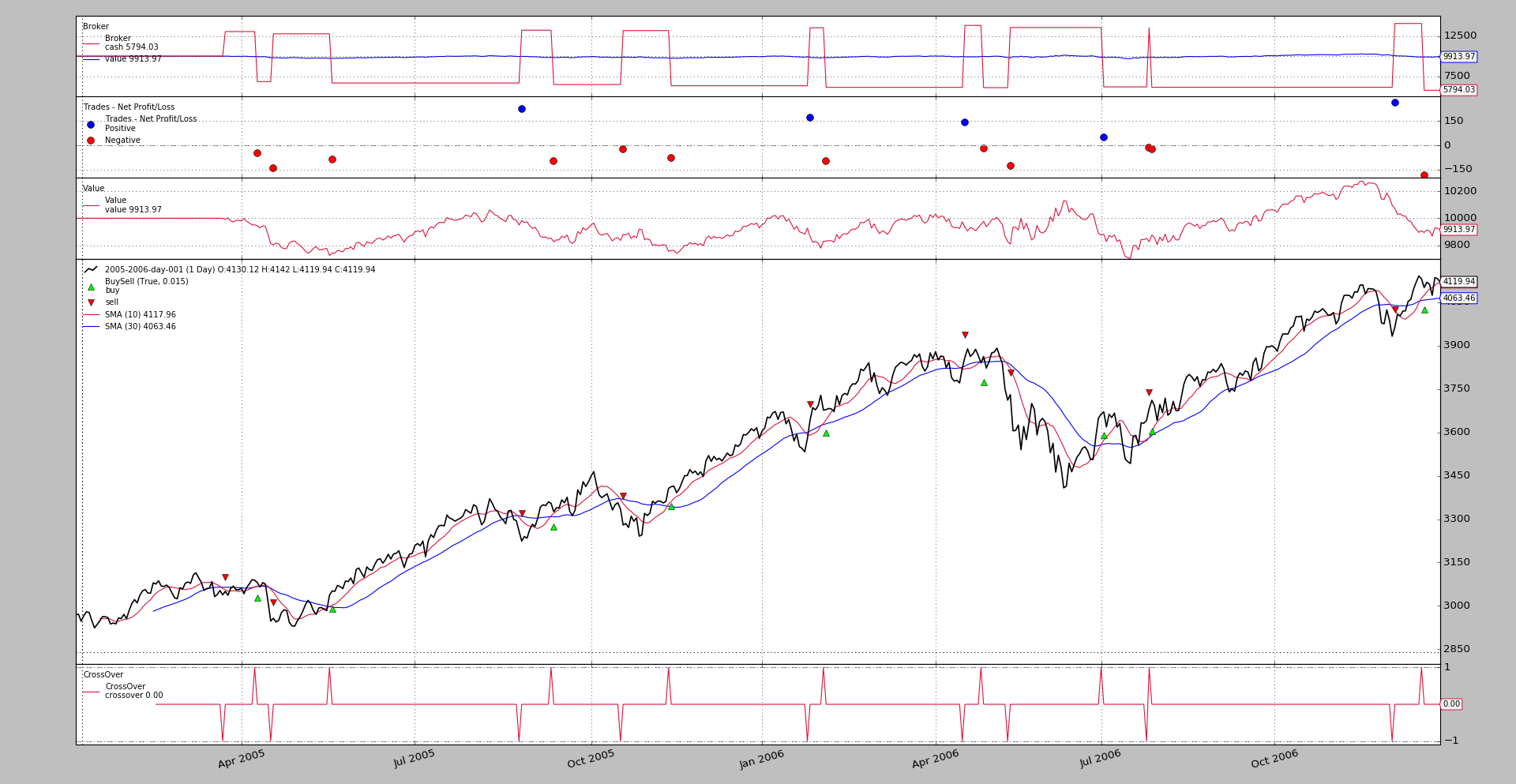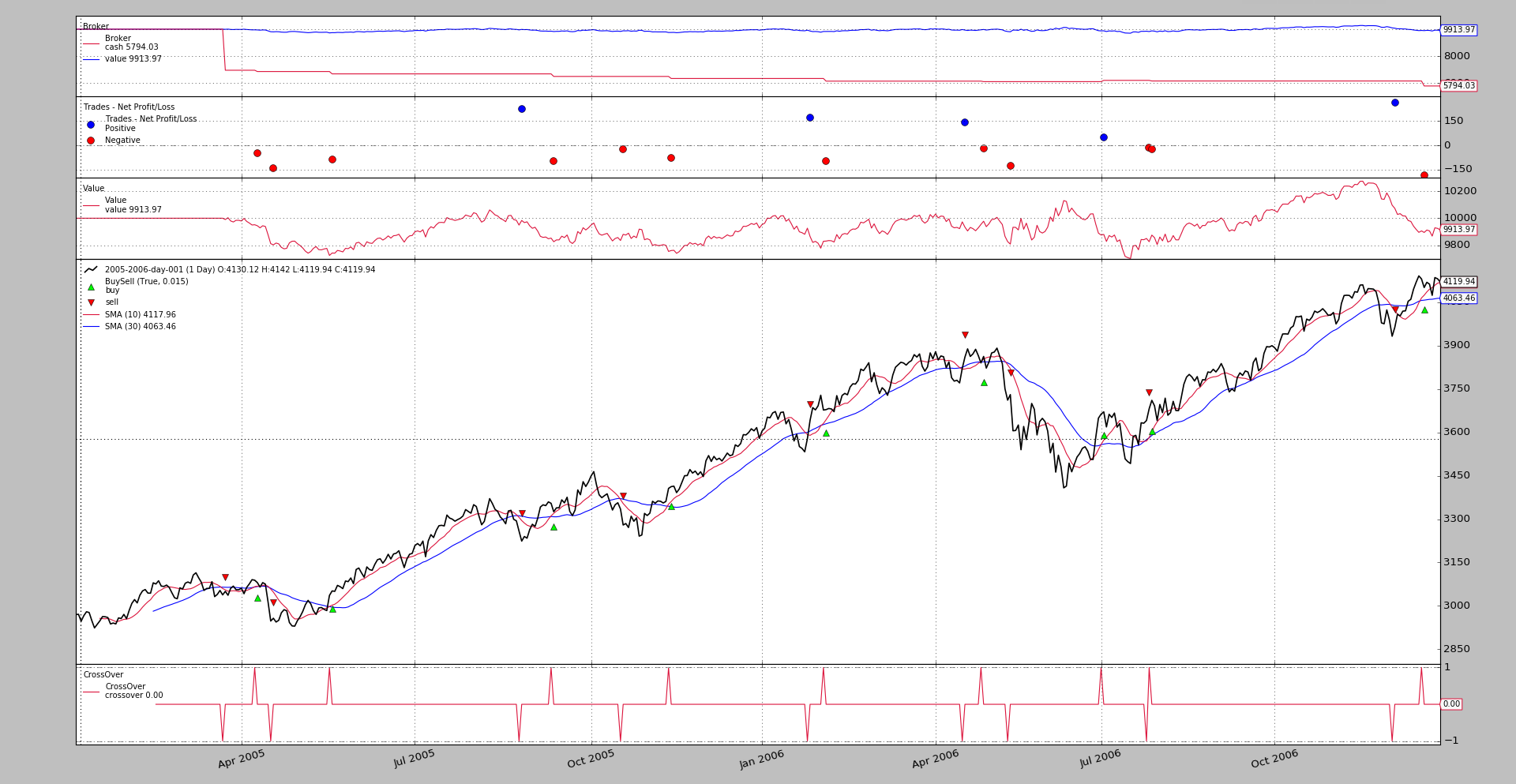Shorting the cash
From the very first moment backtrader was enabled for shorting anything, including stock-like and future-like instruments. When a short was done, the cash was decreased and the value of the shorted asset used for the total net liquidation value.
Removing from one side and adding to the other keeps things in balance.
It seems that people prefer to have cash increased, which probably lends to more spending.
With release 1.9.7.105, the broker has changed the default behavior to
adding cash and removing value. This can be controlled with the parameter
shortcash which defaults to True. Changing it would be done like this:
cerebro.broker.set_shortcash(False)
or:
cerebro.broker = bt.brokers.BackBroker(shortcash=False, **other_kwargs)
In action
The sample below uses a standard moving average crossover and can be used to see the differences. Running it without arguments and the new behavior:
$ ./shortcash.py --plot
It can be compared with the behavior disabled with:
$ ./shortcash.py --plot --broker shortcash=False
Things that remain the same:
-
Final result
-
Trades
-
Net Liquidation Value evolution
To see this an extra Observer is added to make sure the scaling allows seeing the evolution in detail
What changes:
-
When
shortcashis set toFalsecash never goes above the initial level, because an operation alwasy costs moneyBut with the new default behavior we can already see that the 1st short operation (which happens to be the 1st) adds cash to the system and then how the longs deduct cash from the system (the short is 1st closed, obviously)
Sample Usage
$ ./shortcash.py --help
usage: shortcash.py [-h] [--data DATA] [--cerebro CEREBRO] [--broker BROKER]
[--sizer SIZER] [--strat STRAT] [--plot [kwargs]]
shortcash testing ...
optional arguments:
-h, --help show this help message and exit
--data DATA Data to read in (default:
../../datas/2005-2006-day-001.txt)
--cerebro CEREBRO kwargs in key=value format (default: )
--broker BROKER kwargs in key=value format (default: )
--sizer SIZER kwargs in key=value format (default: )
--strat STRAT kwargs in key=value format (default: )
--plot [kwargs], -p [kwargs]
Plot the read data applying any kwargs passed For
example: --plot style="candle" (to plot candles)
(default: None)
Sample Code
from __future__ import (absolute_import, division, print_function,
unicode_literals)
import argparse
import backtrader as bt
class MACrossOver(bt.SignalStrategy):
params = (('ma', bt.ind.MovAv.SMA), ('p1', 10), ('p2', 30),)
def __init__(self):
ma1, ma2 = self.p.ma(period=self.p.p1), self.p.ma(period=self.p.p2)
self.signal_add(bt.SIGNAL_LONGSHORT, bt.ind.CrossOver(ma1, ma2))
def runstrat(args=None):
args = parse_args(args)
cerebro = bt.Cerebro()
# Data feed
data0 = bt.feeds.BacktraderCSVData(dataname=args.data)
cerebro.adddata(data0)
# Broker
kwargs = eval('dict(' + args.broker + ')')
cerebro.broker = bt.brokers.BackBroker(**kwargs)
# Sizer
kwargs = eval('dict(' + args.sizer + ')')
cerebro.addsizer(bt.sizers.FixedSize, **kwargs)
# Strategy
kwargs = eval('dict(' + args.strat + ')')
cerebro.addstrategy(MACrossOver, **kwargs)
# better net liquidation value view
cerebro.addobserver(bt.observers.Value)
# Execute
cerebro.run(**(eval('dict(' + args.cerebro + ')')))
if args.plot: # Plot if requested to
cerebro.plot(**(eval('dict(' + args.plot + ')')))
def parse_args(pargs=None):
parser = argparse.ArgumentParser(
formatter_class=argparse.ArgumentDefaultsHelpFormatter,
description='shortcash testing ...')
parser.add_argument('--data', default='../../datas/2005-2006-day-001.txt',
required=False, help='Data to read in')
parser.add_argument('--cerebro', required=False, action='store',
default='', help='kwargs in key=value format')
parser.add_argument('--broker', required=False, action='store',
default='', help='kwargs in key=value format')
parser.add_argument('--sizer', required=False, action='store',
default='', help='kwargs in key=value format')
parser.add_argument('--strat', required=False, action='store',
default='', help='kwargs in key=value format')
parser.add_argument('--plot', '-p', nargs='?', required=False,
metavar='kwargs', const='{}',
help=('Plot the read data applying any kwargs passed\n'
'\n'
'For example:\n'
'\n'
' --plot style="candle" (to plot candles)\n'))
return parser.parse_args(pargs)
if __name__ == '__main__':
runstrat()

